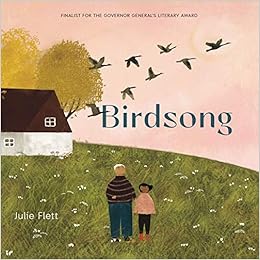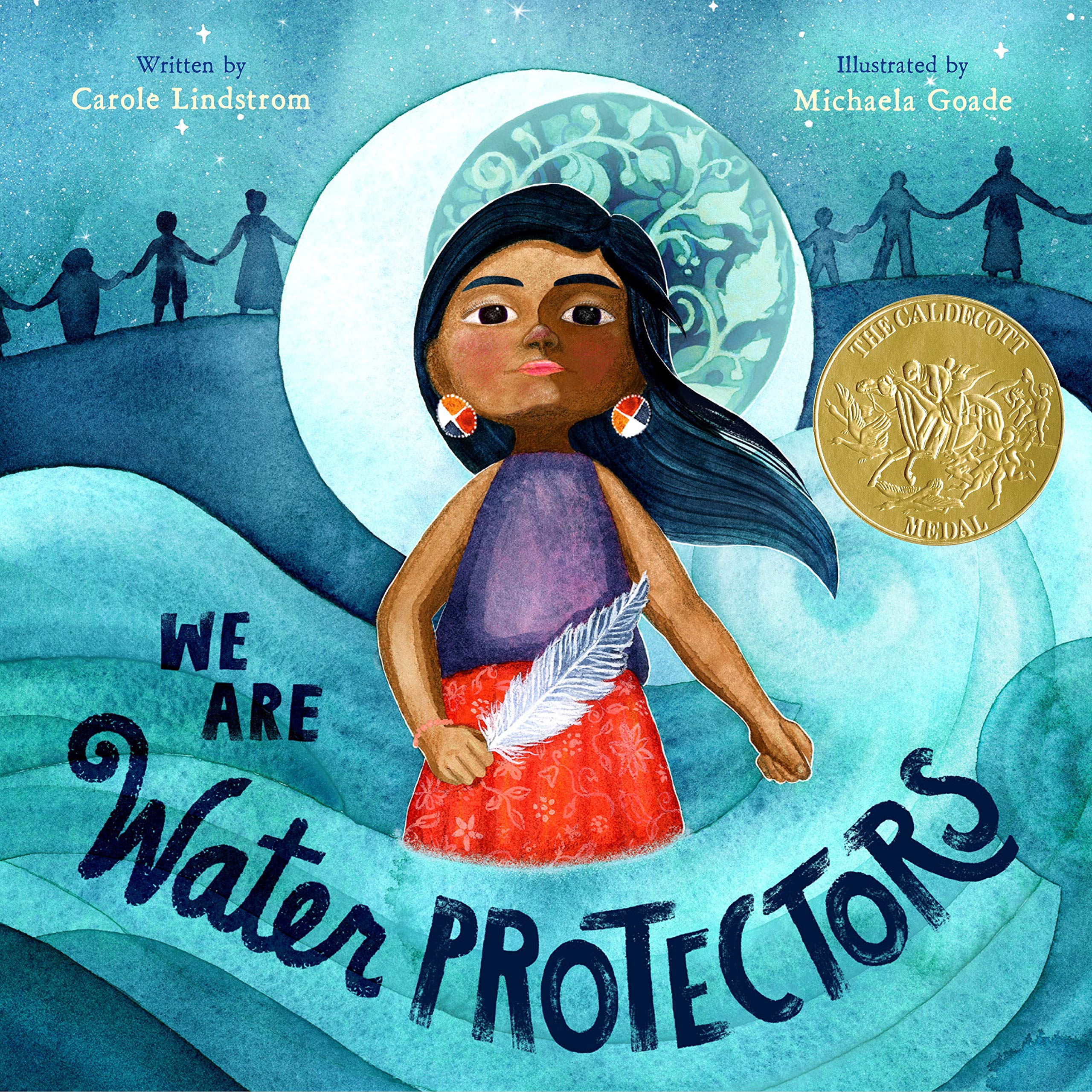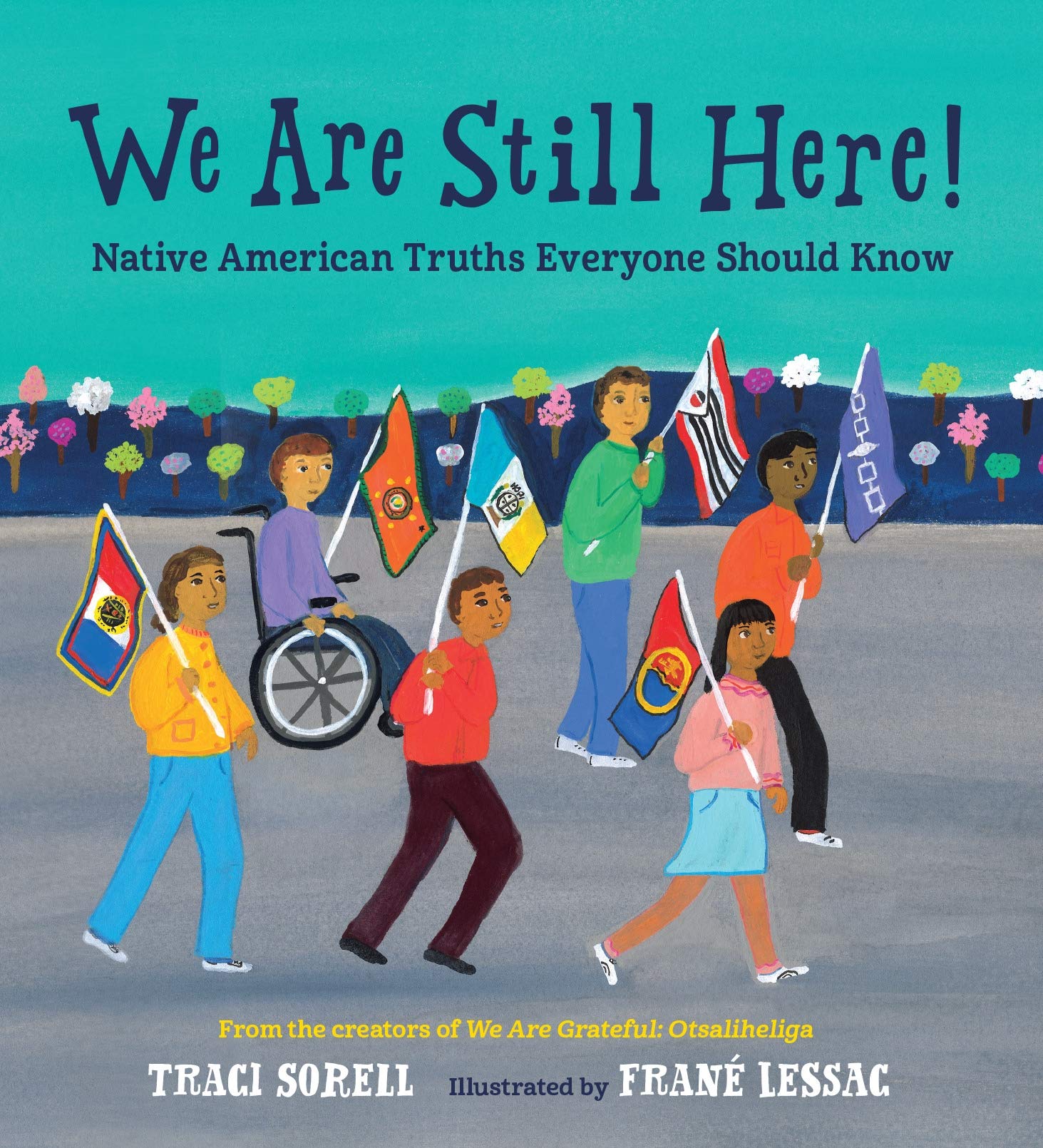Picture Books
Bowwow Powwow by Brenda J. Child, translated by Gordon Jourdain, illustrated by Jonathan Thunder
Published by The Minnesota Historical Society, 2018

When Windy Girl and her dog Itchy Boy go to the powwow, Windy falls asleep and dreams about a powwow populated by dogs. She wakes up just in time to join the last dance. The story is in both English and Ojibwe. Includes an author’s note. 32 pages; grades K-3.
Birdsong by Julie Flett
Published by Greystone Kids, 2019

A beautiful book about intergenerational friendship and the cycles of life. Julie Flett deftly inserts Cree words and imagery into the story. Includes a glossary of Cree words. 48 pages; ages 4-8.
We All Play = Kimêtawânaw by Julie Flett
Published by Greystone Kids, 2021

Children and animals play throughout this simple book that will have kids up on their feet and moving. Includes a list of animals in English and Cree. There’s also additional information on the Cree language, a website readers can visit to hear pronunciations of the words in the book, and a letter from the author. 48 pages; ages 2-7.
Berry Song by Michaela Goade
Published by Little, Brown Books for Young Readers, 2022
A girl learns from her grandmother how to find food in nature: herring eggs and seaweed from the ocean and most of all, berries from the forest. 40 pages; ages 4-8.
Keepunumuk: Weeâchumun’s Thanksgiving Story by Danielle Greendeer, Anthony Perry, and Alexis Bunten illustrated by Garry Meeches Sr.
Published by Charlesbridge, 2022
Maple and Quill love visiting their grandmother N8hkumuhs and hearing her stories. One is of Weeâchumun (corn), and how she and her sisters Beans and Squash helped new people who came to their land in this Thanksgiving story from a Wampanoag perspective. 32 pages; grades K-4.
The First Blades of Sweetgrass: A Native American Story by Suzanne Greenlaw and Gabriel Frey, illustrated by Nancy Baker
Published by Tilbury House Publishers, 2021

Musquon learns from her grandmother the art of gathering and braiding sweetgrass. Includes an author’s note with additional information about sweetgrass and the Wabanaki Confederacy, and a list of the Passamaquoddy-Maliseet words used in the text. 32 pages; ages 4-8.
Remember by Joy Harjo, illustrated by Michaela Goade
Published by Random House Studio, 2023
Former U.S. Poet Laureate Joy Harjo’s poem celebrates life: the cosmos, the Earth, the plants and animals, and people. Caldecott Medalist Michaela Goade’s illustrations depict a child traveling through the universe, with images inspired by traditions from her Tlingit culture. 40 pages; ages 5 and up.
The Secret Pocket by Peggy Janicki, illustrated by Carrielynn Victor
Published by Orca Book Publishers, 2023
Mary and her classmates use ingenuity and teamwork to overcome some of the hardships at their indigenous boarding school in Canada. 32 pages; grades 2-5.
Josie Dances by Denise Lajimodiere, illustrated by Angela Erdrich
Published by The Minnesota Historical Society, 2021

The women in Josie’s family and tribe help her prepare to dance in her first powwow, sewing her costume and giving her her spirit name. Includes a glossary and information about Turtle Mountain, a reservation where the author lives as a citizen of the Tribal Band of Chippewa and the illustrator is a tribal member. 32 pages; ages 4-8.
My Powerful Hair by Carole Lindstrom, illustrated by Steph Littlebird
Published by Harry N. Abrams, 2023
The narrator can’t wait to grow her hair out, believing, as her ancestors did, that hair is a source of strength and memories. Her mother has always had short hair, having been forced to have it cut at an Indian school but eventually decides to join her daughter in the journey of growing her hair long. 48 pages; ages 4-8.
We Are Water Protectors by Carole Lindstrom, illustrated by Michaela Goade
Published by Roaring Brook Press, 2020

The Ojibwe narrator recounts the prophecy of a black snake poisoning the water; now it seems that prophecy has come true, and she joins others at Standing Rock to protect the water. Includes author’s and illustrator’s notes with more information about Standing Rock; a glossary of six words from various indigenous languages from the text; and an “Earth Steward and Water Protector Pledge” to sign. 40 pages; grades K-3.
Fry Bread: A Native American Family Story by Kevin Noble Maillard, illustrated by Juana Martinez-Neal
Published by Roaring Brook, 2019

A celebration of many different Native groups that shows the commonality they share in making and eating fry bread. The author shares his fry bread recipe at the end, followed by eight pages that give a lot more historical and cultural information about each page of the main text. 48 pages; ages 3-6.
Zonia’s Rain Forest by Juana Martinez-Neal
Published by Candlewick, 2021

Zonia is Asháninka, the largest indigenous group living in the Peruvian rain forest. She loves playing all day with her animal friends, but at the end of the day she is disturbed when she finds the stumps of trees that have been cut down. Her mother tells her the forest is calling to her, and Zonia promises to help. Includes additional information about the Asháninka, the Amazon and threats to it, and Zonia’s animal friends in order of appearance. Spanish version also available: La Selva de Zonia. 40 pages; ages 4-8.
When the Shadbush Blooms by Carla Messinger with Susan Katz, illustrated by David Kanletakeron Fadden
Published by Lee and Low Books, 2020

Two girls from a Lenni Lenape tribe, Traditional Sister and Contemporary Sister describe their lives with their families through the course of one year. Includes information on the Lenni Lenape people, as well as some of the cultural features portrayed in the book. 32 pages; ages 4-8.
Grandma’s Tipi: A Present-Day Lakota Story by S. D. Nelson
Published by Harry N. Abrams, 2023
Clara spends a summer on the Standing Rock reservation with her unci (grandmother) and cousin Juniper. 40 pages; grades 2-4.
On the Trapline by David A. Robertson, illustrated by Julie Flett
Published by Tundra Books, 2021

Moshom (Grandpa) hasn’t been to the trapline in the northern wilderness since he was a boy, but now he and his grandson are going back for a visit. Includes notes from the author (who made a similar journey with his father) and the illustrator, as well as a glossary of Swampy Cree words. 48 pages; grades 1-5.
Just Like Grandma by Kim Rogers, illustrated by Julie Flett
Published by Heartdrum, 2023
Becca learns to bead, paint, and dance from her grandmother. As she grows up, Becca starts sharing some of her own passions, like basketball, with Grandma. 32 pages; ages 4-8.
At the Mountain’s Base by Traci Sorell, illustrated by Weshoyot Alvitre
Published by Kokila, 2019

A family gathers and sings, while thinking of a member of the family who’s in the military and praying for her safety and for peace. Includes an author’s note about American Indian and Alaska Native women who have served in wars. One pilot in particular is profiled, Ola Mildred Rexroat, who was the only Native woman among 1074 Women Airforce Service Pilots (WASPs) in World War II. 32 pages; ages 4-8.
Powwow Day by Traci Sorell, illustrated by Madelyn Goodnight
Published by Charlesbridge, 2022
Powwow day is exciting, but River’s watching from the sidelines this year while recovering from a long illness. The dances inspire her, though, and fill her with strength and certainty that she’ll be participating again next year. 32 pages; ages 4-8.
We Are Grateful: Otsaliheliga by Traci Sorell, illustrated by Frané Lissac
Published by Charlesbridge, 2018

Cherokee people express gratitude as they move through the seasons of the year. Cherokee words and their pronunciations are scattered throughout the text. End matter includes a glossary, an author’s note, and a Cherokee syllabary with some lessons about the Cherokee language. 32 pages; ages 4-8.
I Sang You Down from the Stars by Tasha Spillett-Sumner, illustrated by Michaela Goade
Published by Little, Brown Books for Young Readers, 2021
As a mother awaits her baby’s arrival, she gathers items for a medicine bundle: an eagle feather, cedar and sage, a handmade star blanket, and a stone. The author’s note tells how the story connects to her Inniniwake Nation. 32 pages; ages 4-8.
Chapter Books
Rez Dogs by Joseph Bruchac
Published by Dial Books, 2021

Malian is visiting her grandparents on a Wabanaki reservation when Covid hits. She loves her grandparents but is sometimes bored, lonely, and frustrated by spotty Wi-Fi. A rez dog provides her with some company and helps her to better appreciate her family and their culture. 192 pages; grades 3-7.
The Used-to-Be Best Friend (Jo Jo Makoons series) by Dawn Quigley, illustrated by Tara Audibert
Published by Heartdrum, 2021

Jo Jo’s a first grader on the Ojibwe reservation with her own unique take on how to deal with family, friends, and her teacher. Includes a glossary of Ojibwe and Michif words and additional information about the Ojibwe people. 80 pages; grades 1-4.
Ancestor Approved: Intertribal Stories for Kids by Cynthia Leitich Smith
Published by Heartdrum, 2021
Kids from all over the United States and Canada come together for the Dance for Mother Earth Powwow in Ann Arbor Michigan in this anthology of short stories by different Native authors. 320 pages; grades 4-7.
Sisters of the Neversea by Cynthia Leitich Smith
Published by Heartdrum, 2021

An updated Peter Pan story, featuring stepsisters Lily, who is Muscogee Creek, and Wendy, a white girl originally from England. Take that, patriarchy! Includes an author’s note that discusses the questions she had about the original story that led her to create this one. 320 pages; grades 4-7.
Healer of the Water Monster by Brian Young
Published by Heartdrum, 2021
On a summer visit to his grandmother on the Navajo reservation, Nathan discovers his ability to see Holy Beings and must help one of them, Pond, who has been poisoned by radiation. 368 pages; grades 4-7.
Nonfiction
Unstoppable: How Jim Thorpe and the Carlisle Indian School Football Team Defeated Army by Art Coulson, illustrated by Nick Hardcastle
Published by Capstone, 2018

Given the subtitle, you know from the start the outcome of this game between the West Point team that included Dwight Eisenhower and the Carlisle Indian School team featuring Jim Thorpe and coach Pop Warner. The history behind it and the new kind of football that the Carlisle team played add multiple dimensions to the story. Includes additional information on Thorpe, Warner, and the Carlisle Indian School, as well as a glossary and list of sources. 40 pages; grades 3-6.
Sharice’s Big Voice: A Native Kid Becomes a Congresswoman by Sharice Davids with Nancy K. Mays, illustrated by Joshua Nageshig Pawis-Steckley
Published by HarperCollins, 2021

Sharice Davids narrates the journey that led to her 2018 election as a representative from Kansas, one of the first two Native American women in Congress, and the first LGBTQ Native American there. 40 pages; grades K-4.
Indigenous Ingenuity: A Celebration of Traditional North American Knowledge by Deidre Havrelock and Edward Kay
Published by Christy Ottaviano Books, 2023
Before making contact with Europeans, indigenous people had technologies to assist them with communication, transportation, agriculture, health care, and more. As their lands were increasingly taken over, they often hid these technologies, but today, as the author says, they are often hidden in plain sight: when we eat maple sugar, paddle a kayak, or marvel at astronomical wonders. 272 pages; grades 4-8.
If You Lived During the Plimoth Thanksgiving by Chris Newell, illustrated by Winona Nelson
Published by Scholastic, 2021
The question-and-answer format traces the history and culture of the Wampanoag people, the Europeans who sailed on the Mayflower, and what happened when their paths crossed. This story doesn’t end with the 1621 harvest feast but continues on to what happened in the years afterward as Europeans increasingly moved onto indigenous lands and killed many of the people with wars and disease. 96 pages; grades 2-5.
Wilma’s Way Home: The Life of Wilma Mankiller by Doreen Rappaport, illustrated by Linda Kukuk
Published by Disney-Hyperion, 2019

How Wilma Mankiller became the first woman to be elected chief of the Cherokee nation in 1985. Includes notes from the author and illustrator, a timeline, a pronunciation guide for the Cherokee words used in the text, and lists of additional resources. 48 pages; grades 1-5.
Undefeated: Jim Thorpe and the Carlisle Indian School Football Team by Steve Sheinkin
Published by Roaring Brook, 2017

A longer, more detailed account of Jim Thorpe’s football career on the Carlisle Indian School Football Team, including the 1911 game with West Point which drew a bigger crowd than any other American sporting event that year. 288 pages; grades 5-10.
Contenders: Two Native Baseball Players, One World Series by Traci Sorell, illustrated by Arigon Starr
Published by Kokila, 2023
The story opens with a key moment of the 1911 World Series: Charles Bender of the Philadelphia Athletics pitching to John Meyers of the New York Giants and goes on to tell the story of these two athletes, both from Native Nations, who went on to play in a total of nine World Series. 48 pages; grades 1-5.
We Are Still Here! Native American Truths Everyone Should Know by Traci Sorell, illustrated by Frané Lissac
Published by Charlesbridge, 2021

A group of kids from the Native Nations Community School puts together a presentation for Indigenous People’s Day. There are reports on such topics as assimilation, relocation, tribal activism, and language revival. Includes additional information on each presentation; a timeline covering 1870-2007; a glossary of terms and a list of sources; and an author’s note giving more information about the book and her personal connection to Native history (she’s a dual citizen of the Cherokee Nation and the United States). 40 pages; grades 2-5.
Finding My Dance by Ria Thundercloud, illustrated by Kalila J. Fuller
Published by Penguin Workshop, 2022
Ria Thundercloud tells the story of her dance career, from her days on the powwow circuit to a career in classical dance, and a return to her roots in this celebration of dance and indigenous cultures. 40 pages; grades 1-5.














